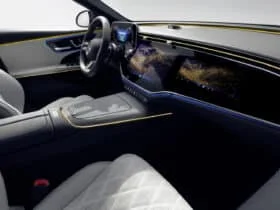BMW has always been a byword for cutting-edge design, powerful engines, and opulence. The legendary brand, which goes by the slogan “The Ultimate Driving Machine,” has been around for more than a century and is home to several pioneering innovations and legendary models. Hidden realities and lesser-known facts about the company exist beneath the surface, though, and even the most dedicated fans might not know them. Listed below are eleven things that BMW would like you not to know.
To begin, it is important to recognize that BMW’s path hasn’t always been easy. The firm, which started off making engines for airplanes, came dangerously close to insolvency on many occasions in its early years. The Treaty of Versailles, which prohibited Germany from manufacturing aviation engines following WWI, put BMW in a difficult situation. The business shifted its focus from engines to railway brakes, agricultural machinery, and motorcycles in order to stay afloat. This adaptability kept BMW afloat, but it was very different from the high-end automaker of today.
Another interesting truth is that the kidney grille, a trademark design element on all BMW automobiles, wasn’t initially intended to be aesthetically pleasing. To cool the engines more effectively, it was originally a utilitarian design option. But it developed into a unique design feature throughout time, and now it’s an emblem of the automobile industry. The recent substantial enlargement of this iconic grille on several new models by BMW has sparked controversy among automobile aficionados and made it the topic of considerable debate. Although they haven’t said it publicly, the company’s decision to make the grille so prominent is probably an attempt to set their newest models apart in the competitive luxury market.
Another design secret is that the blue and white roundel emblem, which is instantly recognizable as BMW, is frequently confused for something else. As a tribute to BMW’s roots in the aviation industry, many see it as a spinning propeller of an airplane. But the corporation has been slow to dispel this misconception. The emblem pays homage to the blue and white hues of Bavaria, the German state that was the birthplace of BMW. Though it didn’t surface until much later, the propeller myth became ingrained in BMW’s reputation as a technical powerhouse.
The fact that BMW does not manufacture all of their vehicles in Germany is one of the most shocking facts about the company. Even though BMW’s German plants are still very much a part of the brand, many of the cars they sell are actually produced in places like China, South Africa, and the US. For example, the majority of BMW’s X-Series SUVs are assembled at the Spartanburg, South Carolina, factory, which also happens to be the biggest production facility on the planet. Many BMWs that come off the manufacturing lines are actually American-made, even though the name is often linked with German engineering. When it comes to marketing, BMW hardly ever mentions its multinational production process.
While BMW’s reputation for producing “The Ultimate Driving Machine” is based on decades of technical advancement, the performance of not all BMWs has been commensurate with that slogan. The existence of other versions that were commercial failures is a well-guarded secret in the history of the firm. As an example, the BMW 8 Series, which debuted in the early 90s, was utterly unsuccessful. Sales were low since the vehicle was overpriced, complicated, and released during a worldwide economic downturn. Today, BMW is far more cautious with price and market timing, and the 8 Series has been resurrected with a more contemporary take.
Although the majority of automakers prioritize lightweighting as a means to enhance performance, BMW takes an unconventional and underappreciated approach to this matter. Carbon fiber reinforced plastic (CFRP) is an exceptionally lightweight and robust material that the firm has used in a number of its products. This is in line with BMW’s efforts to decrease vehicle weight while maintaining safety and performance. Unfortunately, many buyers are unaware that CFRP is expensive to manufacture and, if damaged, necessitates specialist repairs, which can drive up the cost of repairs after an accident. BMW is rather vocal about the advantages of CFRP for its cars, but they are far less forthcoming about the disadvantages that buyers may face.
The intricate connection between environmental responsibility and elegance is another underappreciated facet of BMW vehicles. Despite the success of its i3 and i8 electric vehicles, BMW has lagged behind some of their rivals in completely embracing electrification. Although it still makes a lot of high-performance gasoline-powered cars, the company has taken heat for its aggressive advertising of electric and hybrid versions. Although the transition has been slower than some eco-activists would want, BMW’s long-term goal, “Project i,” implies that the firm is dedicated to more sustainable operations.
An additional interesting aspect of BMW’s electric car approach becomes apparent upon closer inspection: When it comes to fuel cells that run on hydrogen, BMW was an early adopter. Despite all the talk about electric cars lately, BMW has been secretly working on hydrogen-powered vehicles for quite some time. When it comes to bigger cars and long-distance travel, the corporation views hydrogen as a good substitute for electric batteries. Even if they haven’t brought hydrogen-powered vehicles to market just yet, the corporation is still investing in the technology.
Involvement with the Nazi war effort during WWII is another secret that BMW probably doesn’t want widely recognized. During that period, BMW was a German firm that used forced labor in its plants to manufacture aircraft engines for the German military. Despite BMW’s public apologies and recognition of its participation in the war, the official narratives of the corporation tend to minimize this aspect of its history. This unpleasant reality casts a shadow over BMW’s early heritage, despite the fact that the corporation has made efforts to put that chapter in the past in the past.
As a shocking turn in BMW’s narrative, the company nearly went under in the 1950s. Due to financial difficulties, BMW was almost sold to Daimler-Benz after WWII. The little Isetta, a charming bubble vehicle that gained popularity in post-war Europe for its cost and fuel efficiency, saved the firm. It wasn’t the typical high-performance or luxury sports car that we think of when we hear the name BMW, but this strange little vehicle is what kept the firm viable until it could get back into the luxury automobile market.
The long and winding road that is BMW’s past is significantly more complicated than its streamlined appearance would have you believe. Over the years, BMW has overcome many obstacles, including a near-collapse, novel material utilization, misconceptions about its distinctive badge, and contentious engagement in WWII. Even the most prominent corporations have had to battle for their position in the world, and these secrets, which are frequently ignored or concealed, reveal just that.











